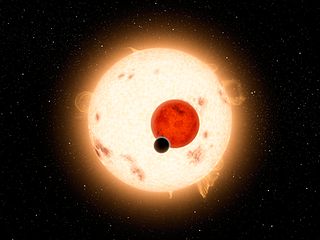Kepler-16
|
Double star Kepler-16 |
|||||
|---|---|---|---|---|---|

|
|||||
| Kepler-16 system | |||||
| AladinLite | |||||
|
Observation dates equinox : J2000.0 , epoch : J2000.0 |
|||||
| Constellation | swan | ||||
| Right ascension | 19 h 16 m 18.18 s | ||||
| declination | + 51 ° 5 ′ 26.8 ″ | ||||
| Typing | |||||
| Known exoplanets | 1 | ||||
| Spectral class | K7 V | ||||
| Variable star type | EA + EP | ||||
| Astrometry | |||||
| Radial velocity | (−32.4 ± 2.6) km / s | ||||
| parallax | 13.29 ± 0.03 mas | ||||
| distance | (245 ± 1) ly (75) pc |
||||
| Proper movement | |||||
| Rec. Share: | (14.04 ± 0.05) mas / a | ||||
| Dec. portion: | (−48.6 ± 0.05) mas / a | ||||
| Physical Properties | |||||
| Dimensions | (0.690 ± 0.004) M ☉ | ||||
| radius | (0.649 ± 0.001) R ☉ | ||||
| Effective temperature | (4450 ± 150) K. | ||||
| Metallicity [Fe / H] | (−0.3 ± 0.2) | ||||
|
Other names and catalog entries |
|||||
|
|||||
Kepler-16 is a double star in the constellation Swan . The system is orbited by a circumbinary exoplanet called Kepler-16b .
Star system
Kepler-16 (AB) are spectroscopic binary stars , the individual components of which could not yet be broken down. The system is counted among the Algol stars due to the variability of the eclipse .
Exoplanet
Kepler-16b is a Exoplanet with a mass of about 0.3 M J . It orbits the two central stars with a period of 228 days at a distance of about 0.7 AU with an eccentricity of about 0.007. Kepler-16b was discovered using the transit method through the Kepler telescope . His discovery was published in 2011.
Web links
Commons : Kepler-16b - collection of images, videos and audio files
Individual evidence
- ↑ a b c d e Kepler-16. In: SIMBAD . Center de Données astronomiques de Strasbourg , accessed on August 27, 2018 .
- ↑ KID 12644769. In: VSX. AAVSO, accessed August 27, 2018 .
- ↑ Nasa Exoplanet Archives
- ↑ a b c Exoplanet.eu

